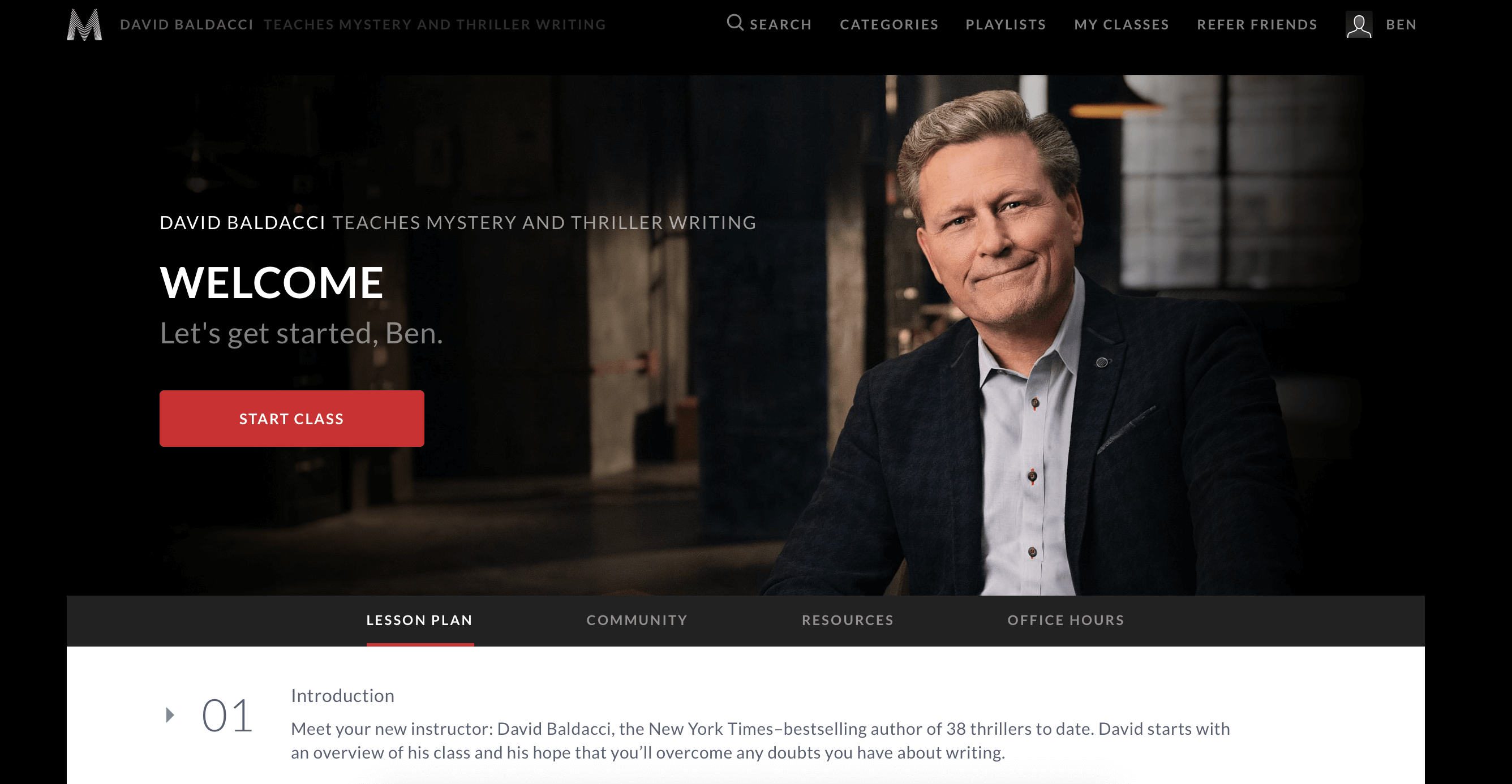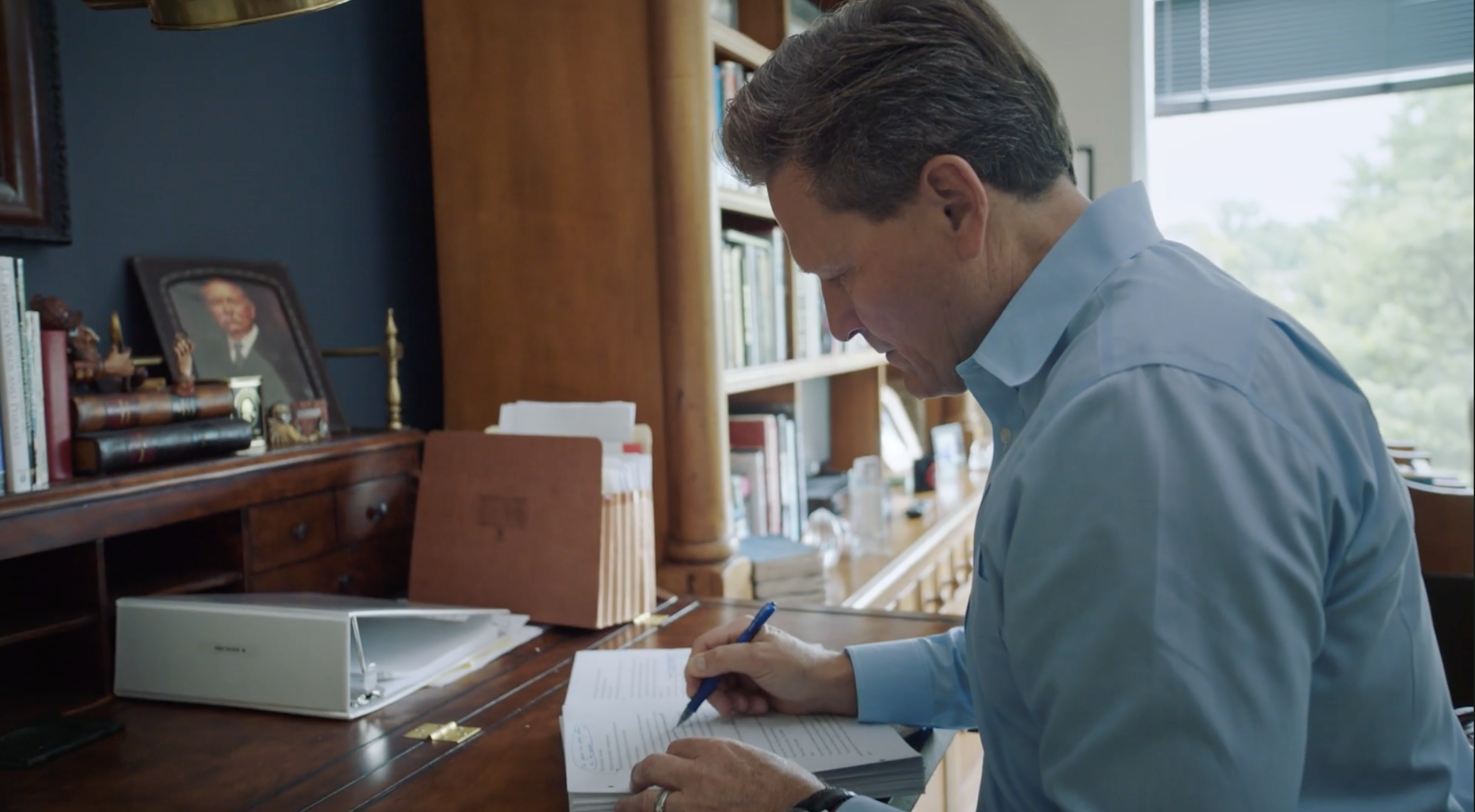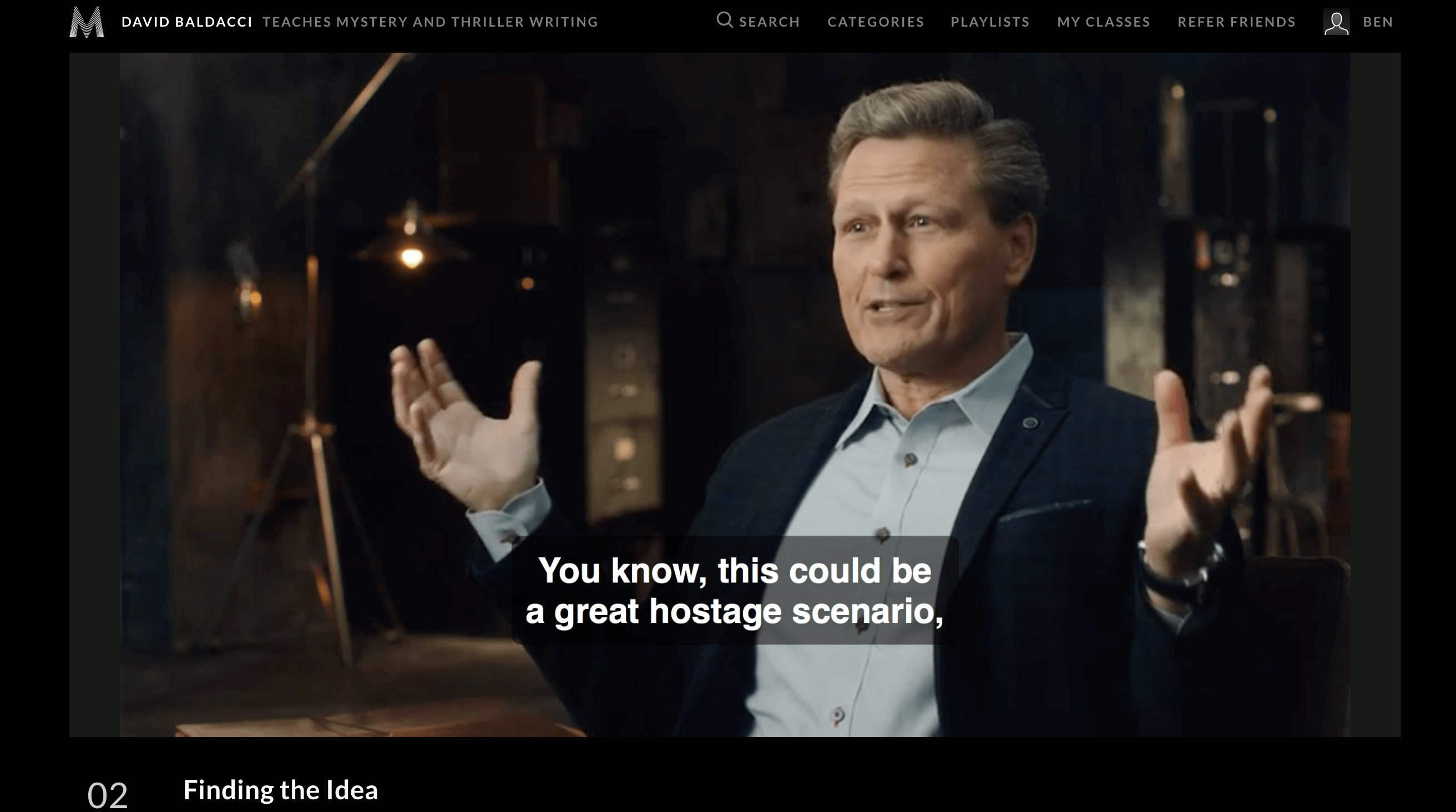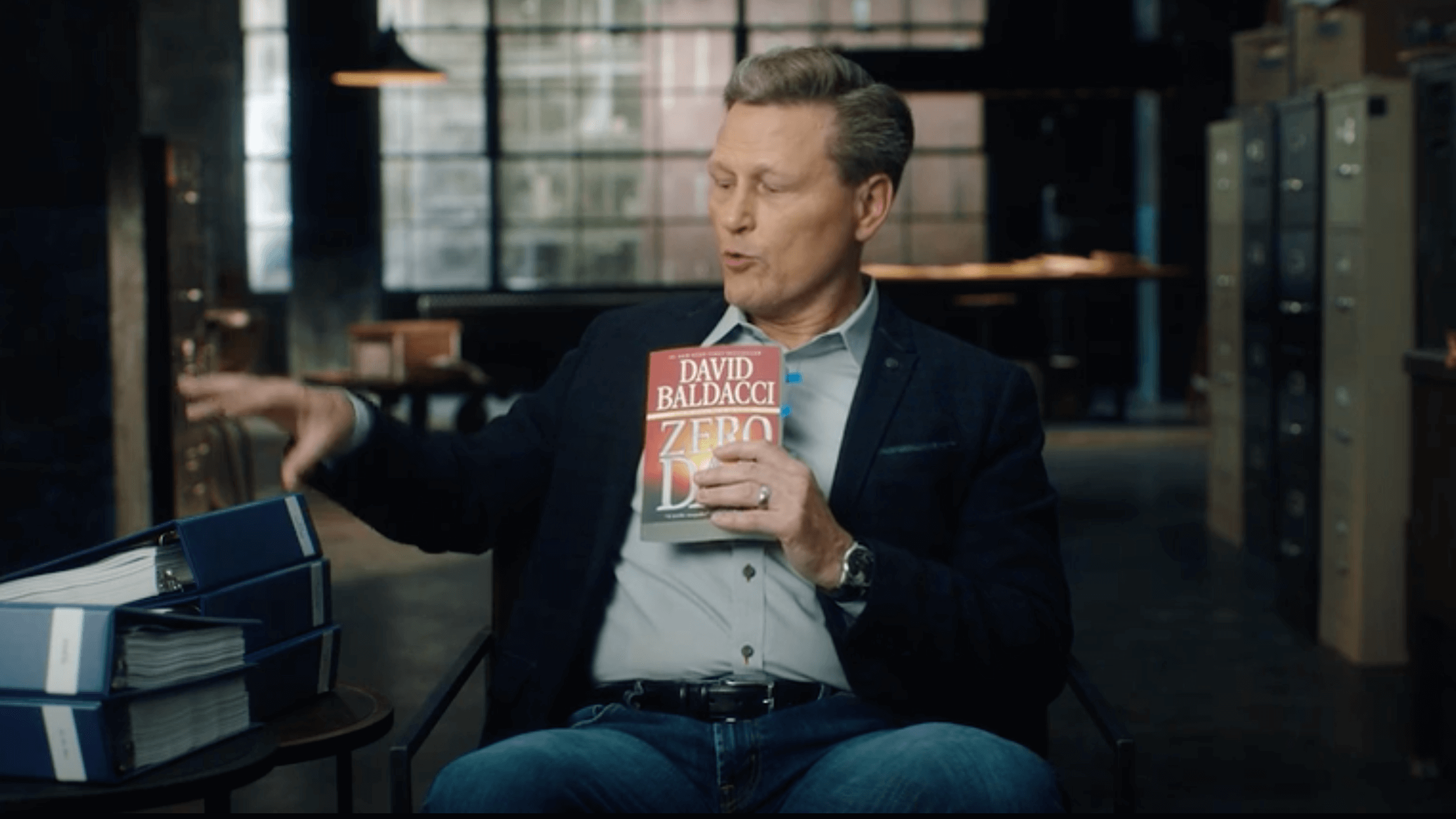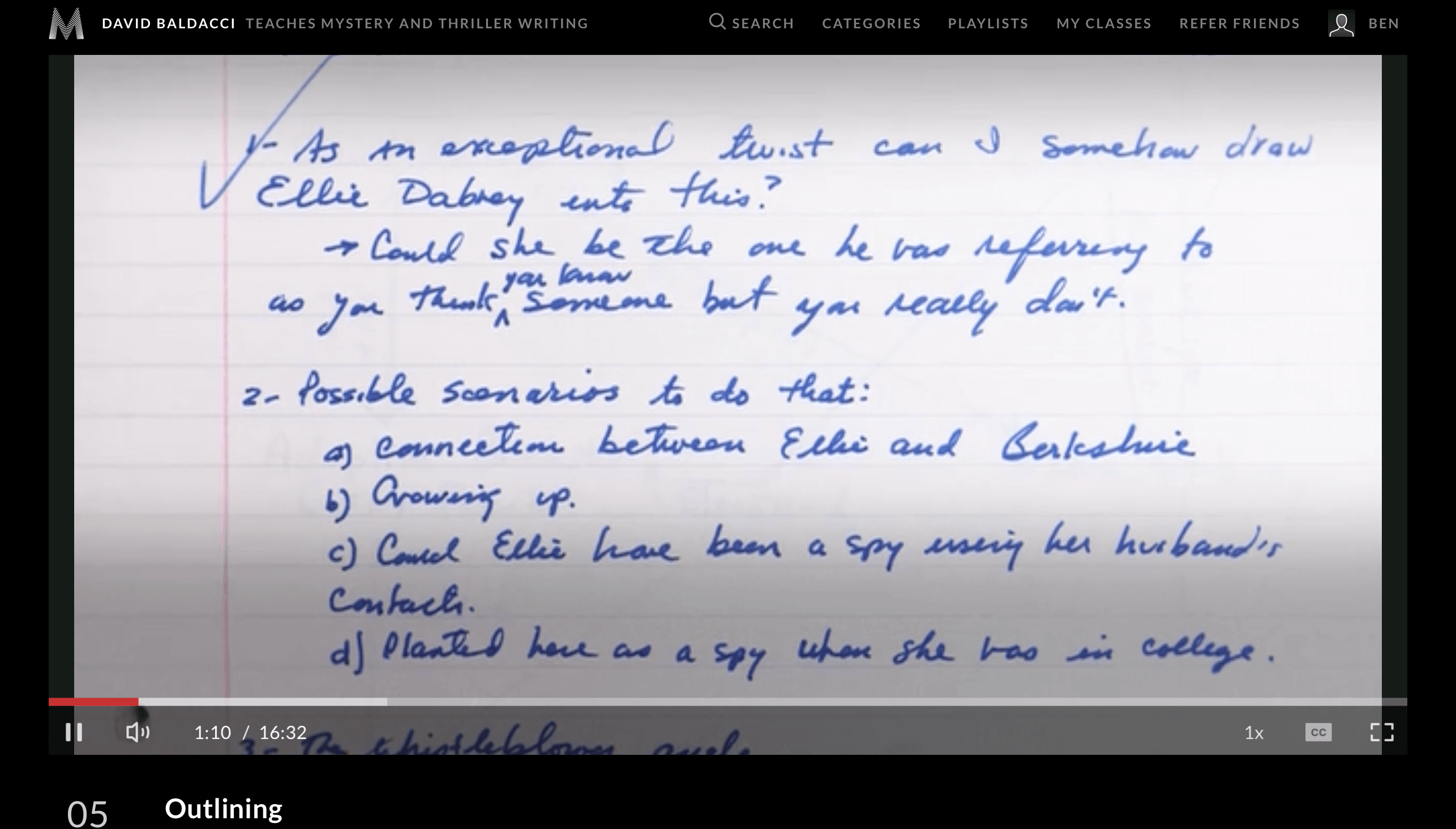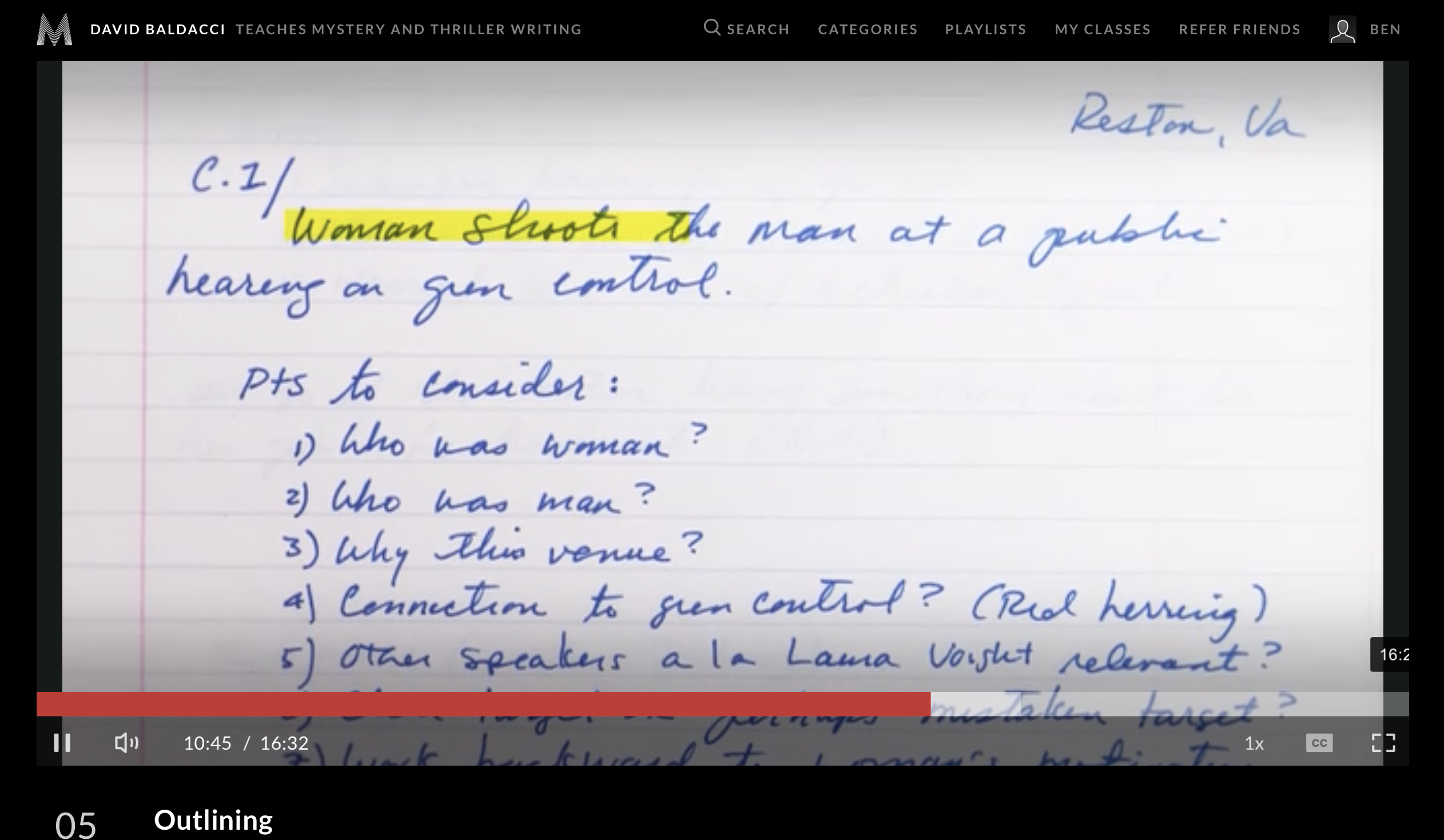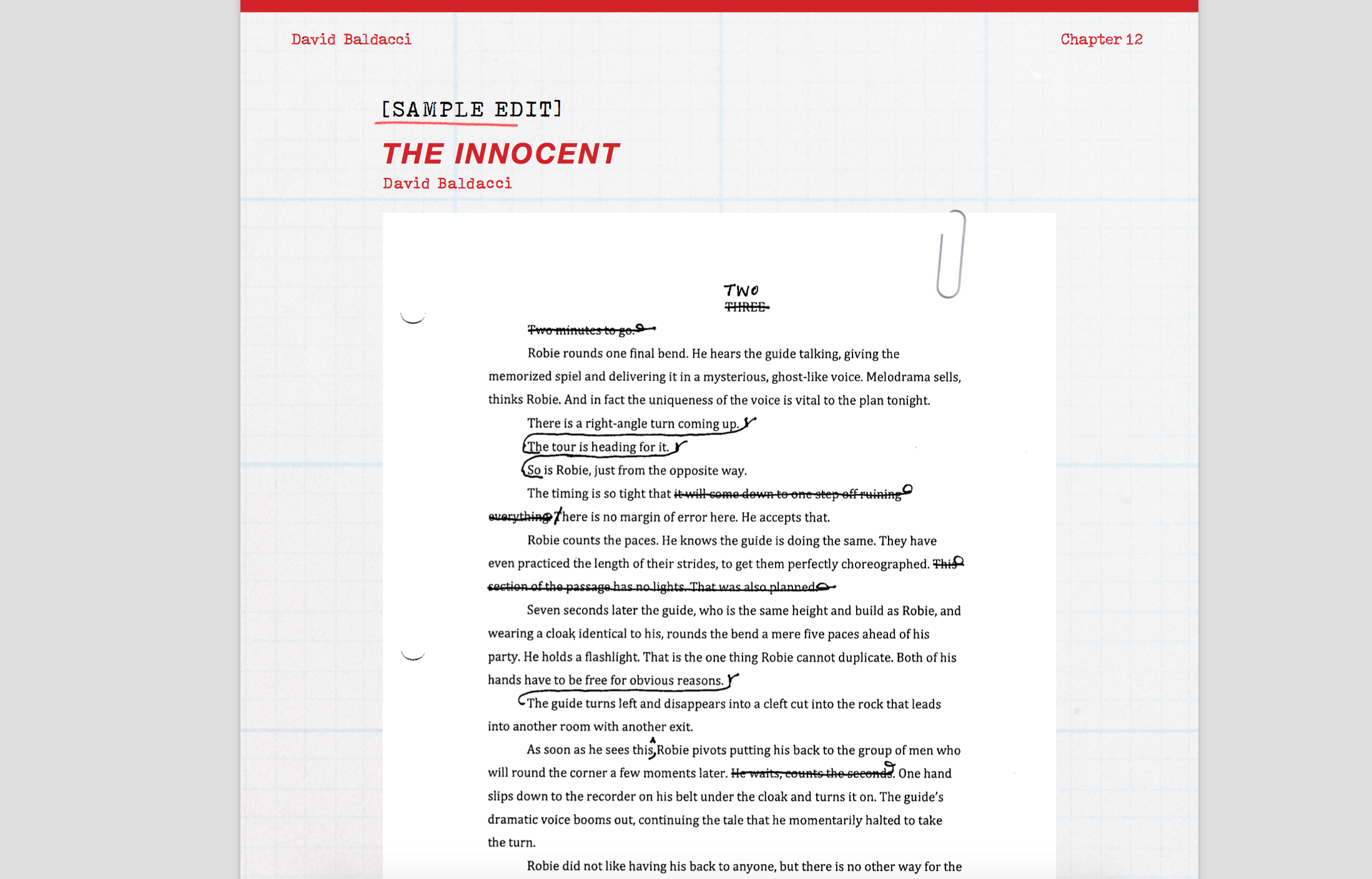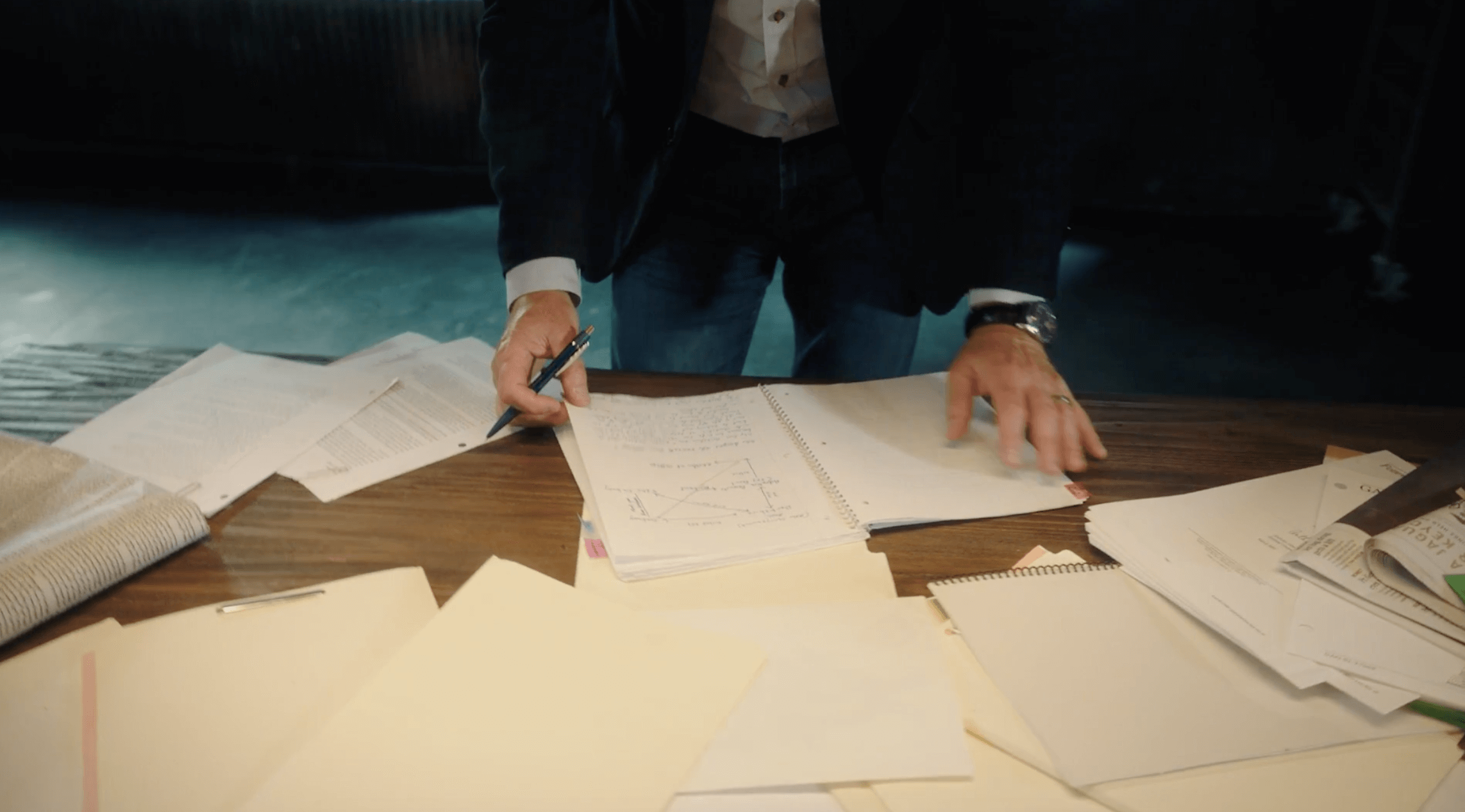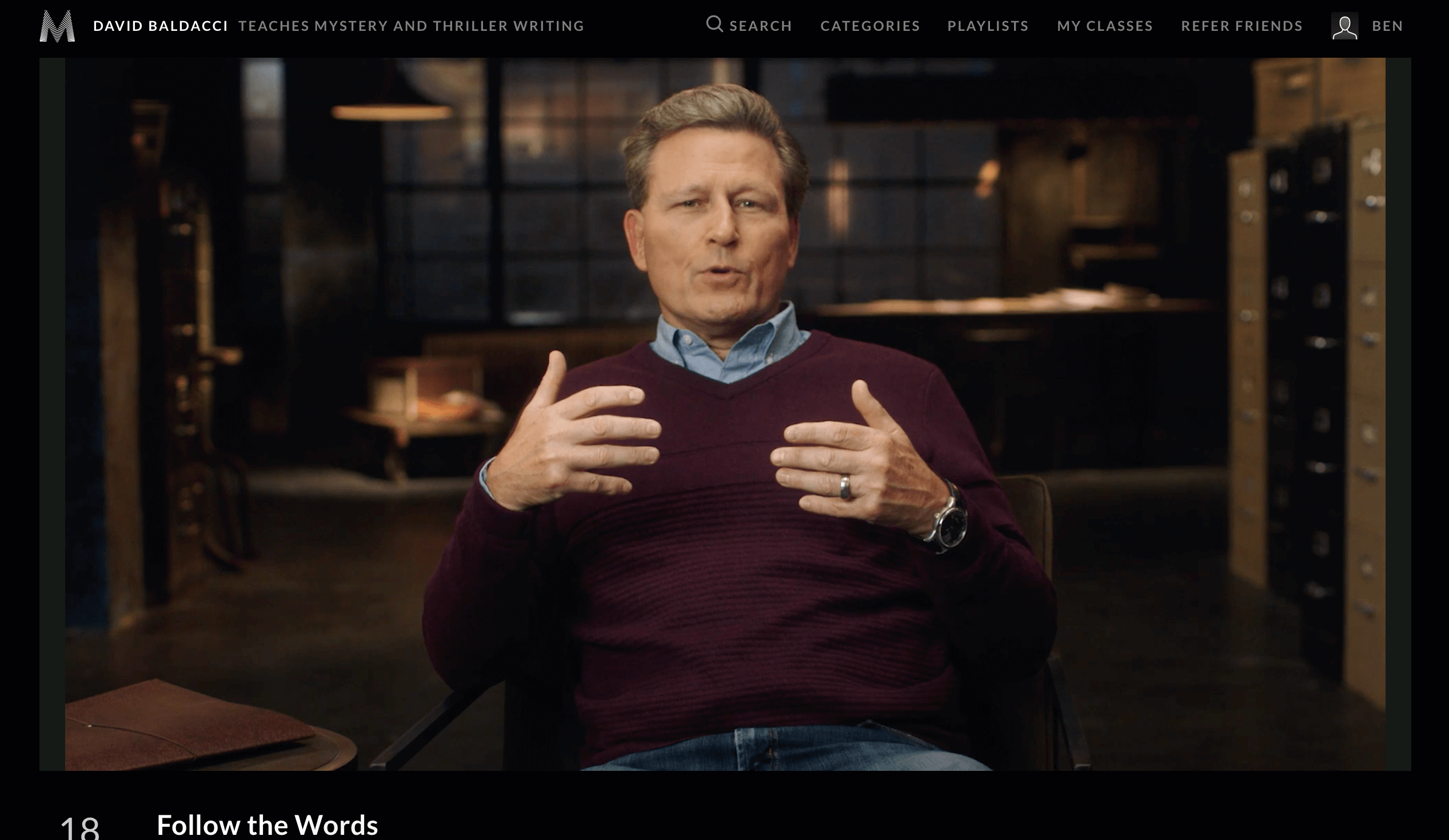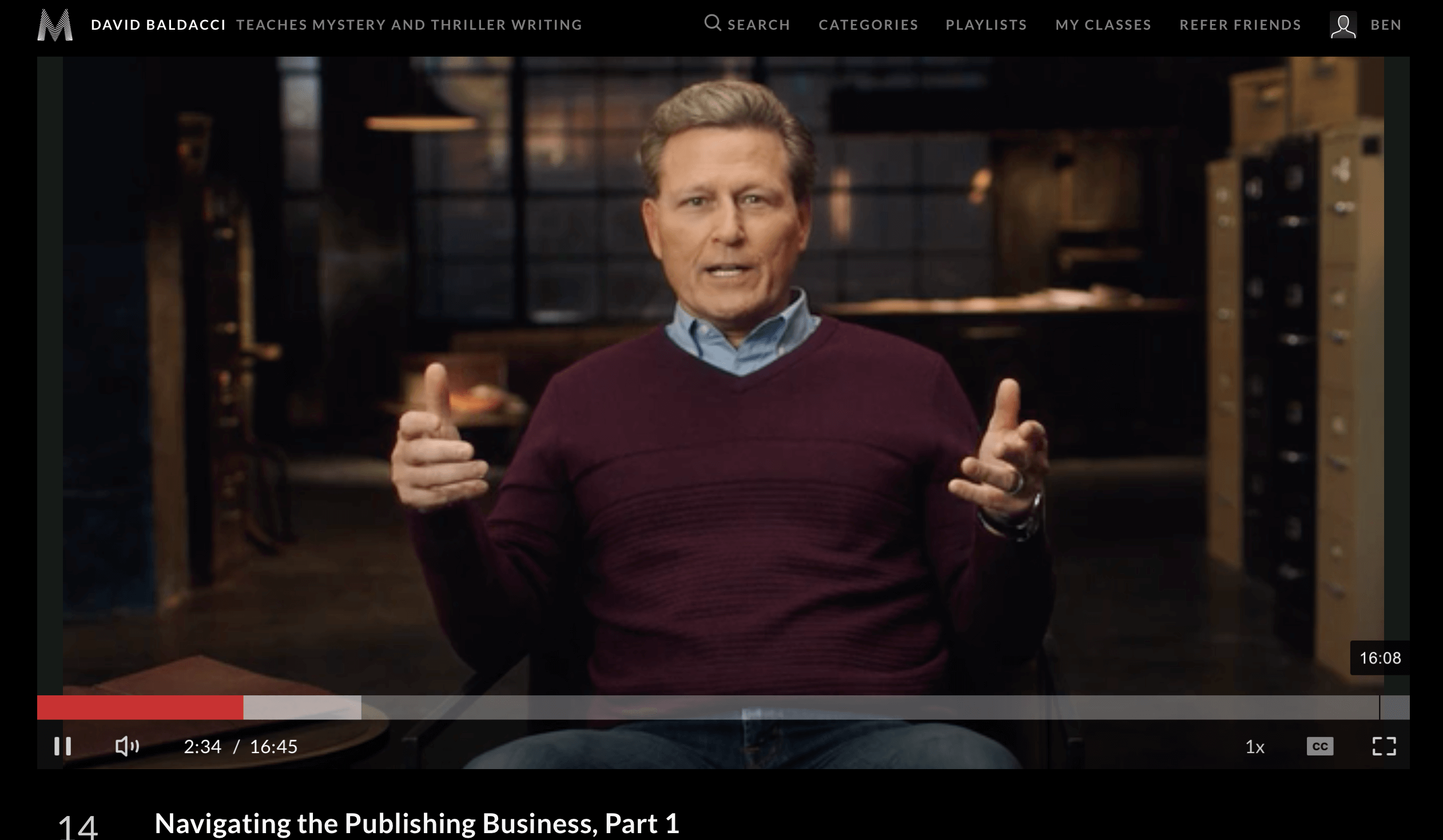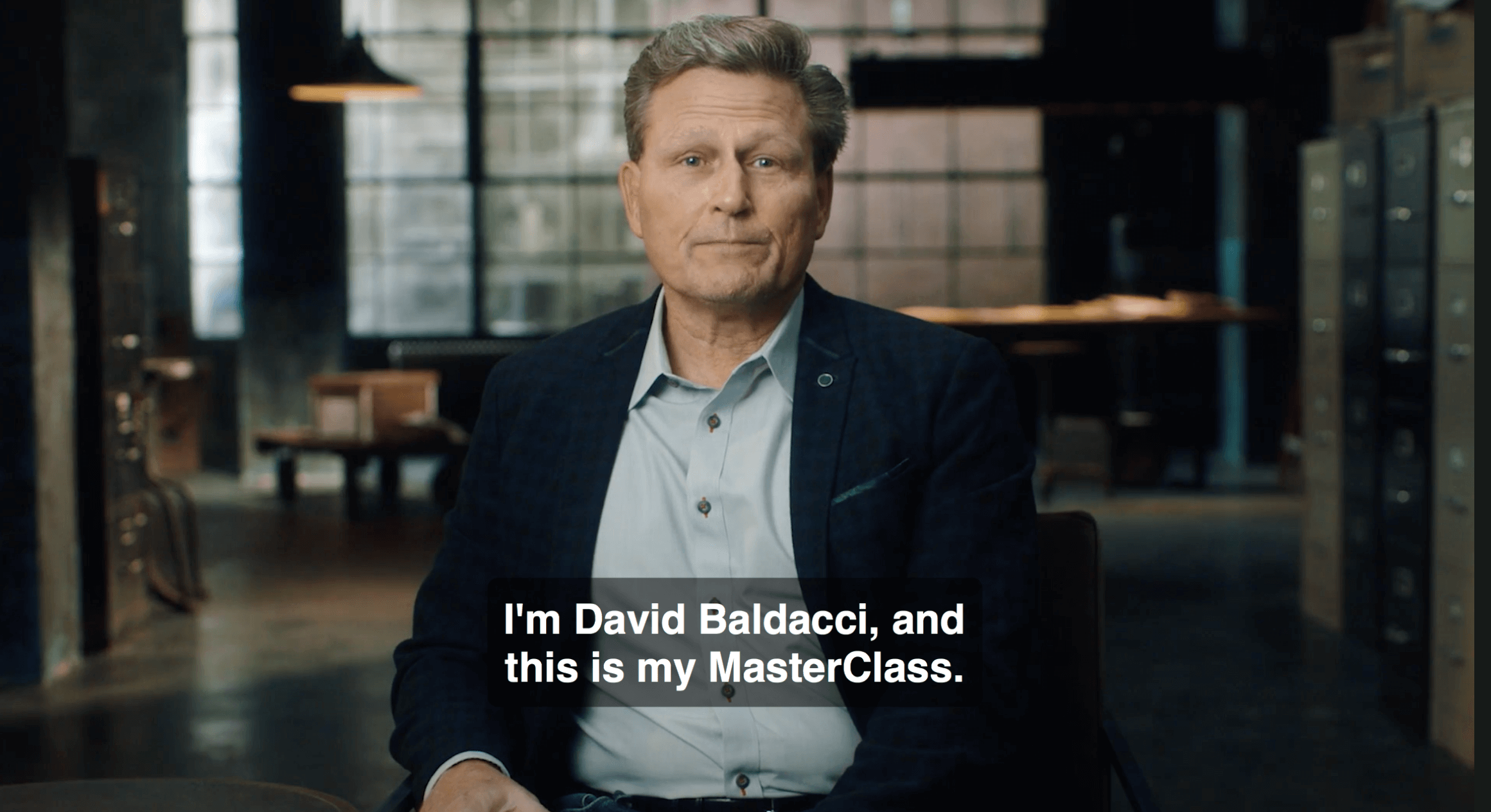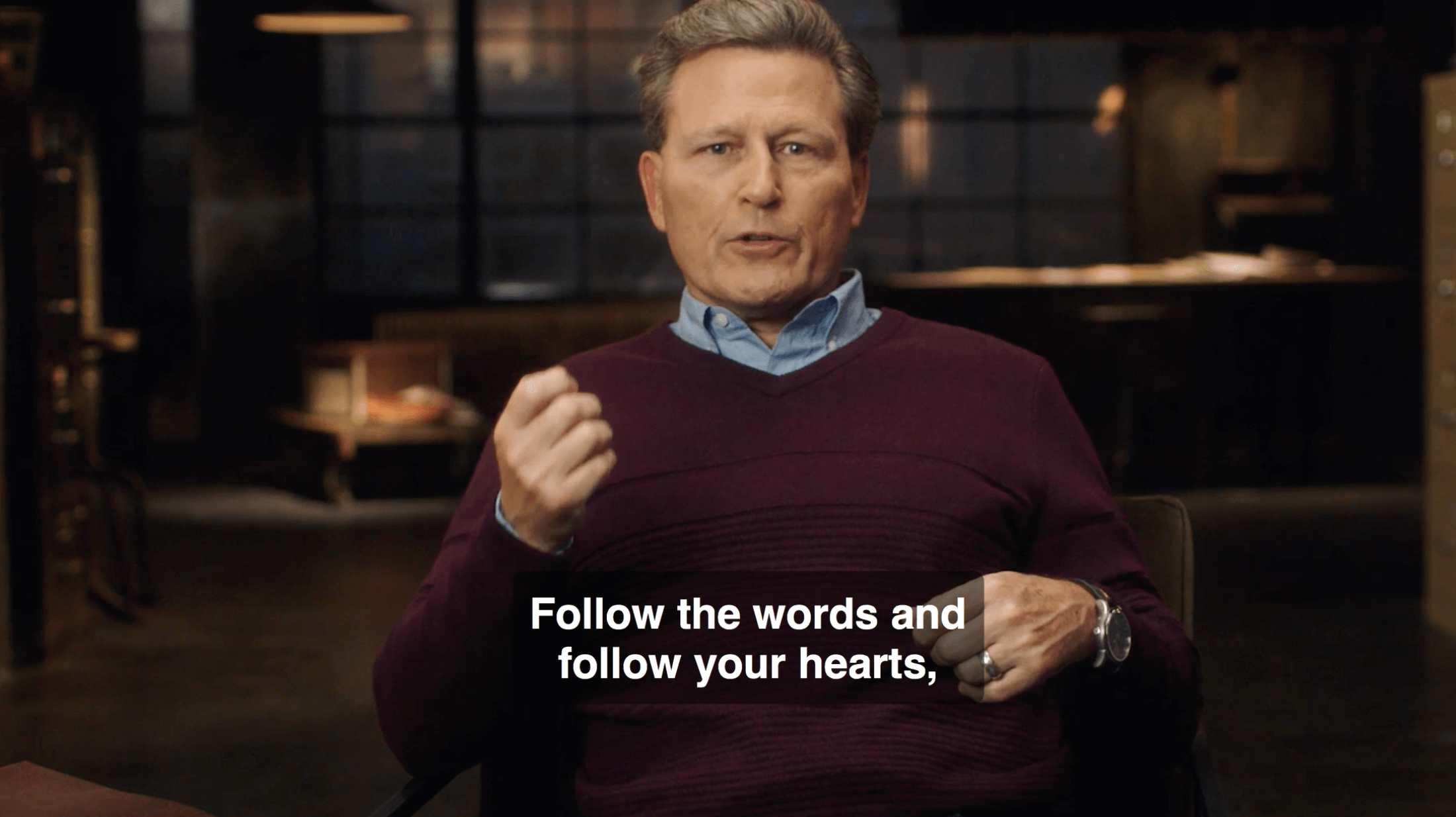Just when I thought I could get a decent night’s sleep… I log into my MasterClass All Access Pass arena and see they’ve done it again. They’ve only gone and snagged David Baldacci to teach you mystery and thriller writing!
At this point, my opinion of MasterClass couldn’t get any higher. It’s already cemented itself as the finest writing suite anywhere. Not just the internet – in the world! And that’s coming from someone who studied English Literature at Oxford.
With every big name hero of mine that gets added to the writing roster at MasterClass, I pray they’re able to at least meet the standard of the ones that came before them. It’s a lofty wish and the bar has already been set super high by the likes of Neil Gaiman, Margaret Atwood, Dan Brown, and many more.
Could the David Baldacci Teaches Mystery and Thriller Writing MasterClass be every bit as good as the man’s novels?
This is what this David Baldacci MasterClass review will reveal.
David Baldacci Teaches Mystery and Thriller Writing MasterClass Review
Once again, MasterClass do a superb job of hooking you right from the intro video.
If you turned this on without knowing what it was or who David Baldacci was, you’d be forgiven for thinking you were watching a legal crime thriller.
Then Baldacci tells us about his motivation for doing this MasterClass. When MasterClass approached him, he didn’t say yes right away. He thought long and hard about how he can truly dissect what it means to be a writer.
This MasterClass covers the entire writer’s journey – everything from holding a day job and scheduling your time (Baldacci was a lawyer working long hours when he started writing) to the fundamentals of story, constructing great characters, how to pace a story so the readers keep turning the pages, how much research you need to do and how to do it and so much more.
The David Baldacci MasterClass also has a workbook filled with manuscript pages, editorial letters, and scenes from books, and different applications Baldacci has used over the course of his career to become a better writer.
You also have two coursework writing assignments.
I won’t reveal what they are but they are superb and will help you whether you’re writing a novel at the moment or if you’re just looking to hone your craft and practice.
The David Baldacci Teaches Thriller and Mystery Writing MasterClass is for any writer who is doubting their ability to tell a story.
As Baldacci says, he’s got your back. This course is for you to take the techniques from Baldacci that work for you, tweak some others to your liking, and throw away the ones that don’t interest you, then you can move on with your career.
All of the writing masterclasses start off with the same topic – how to find ideas.
At this point, you’d think I had no problem finding ideas. But really I stopped writing fiction for a long time when I focused on other things business-wise. So recently, before taking the David Baldacci MasterClass, when it came time for me to drum up ideas, I found it very difficult.
I had forgotten how to find ideas. But David Baldacci’s advice changed that.
This was a great module about how to look at the real world through the writer’s prism and how to sprinkle fictional pixie dust over reality.
This is a lesson aimed at giving you a mindset shift so you see the ordinary world in a completely different way.
By the end of the module, you’ll be able to walk outside your front door and connect the dots of what you see around you to make a compelling story.
You’ll never run out of ideas again.
What’s great is David breaks down his process and shows you how an idea led to an actual book.
If you’ve read David’ Baldacci’s books, you’ll get so much value out of this MasterClass.
It’s like one of those behind-the-scenes director’s commentaries you get on DVDs and I can see this course appealing to David Baldacci fans who aren’t even interested in writing a book.
Of course, you don’t need to have read Baldacci’s works to appreciate the lessons in this MasterClass (there are a lot of them to get through), but I guarantee you’ll want to pick a bunch of his books up as you listen to him talk.
Isn’t that a double win for Baldacci? I always think that when I take these MasterClasses.
Scorsese’s MasterClass compelled me go back to his films. R.L. Stine’s course resulted in me buying ten Goosebumps books. And Baldacci’s course resulted in a heavy binge.
What I really loved about the module on how to find ideas were the discussions about how to choose a central conflict that is morally complex.
David talks all about avoiding black and white issues and how to blur the lines between good and bad so your story doesn’t become predictable.
I also loved the discussion on how to make room for non-fiction in fiction, with reference to my favourite David Baldacci character, Amos Decker (if you need a place to start with David Baldacci books, I recommend Memory Man).
And the discussion on passion, expertise, and how to weave multiple interests together was fascinating.
What’s really great about the David Baldacci MasterClass, and all of the MasterClasses, is you get a lengthy workbook to supplement the video lessons.
Turning to the chapter on finding ideas, along with a bunch of writing exercises that will keep you busy for a long time, you get a fascinating deep-dive into the subject.
In this chapter, for example, the extra lessons are furnished with interesting examples of other writers like Michael Crichton, John le Carré, Dan Brown, and Mario Puzo.
Typically in MasterClass, your exercises and assignments come in the workbook. But at the end of the ideas module, David gives you a writer’s exercise that he picked up in a writing workshop almost like a bonus.
I’ve gotta say, this is one of my favourite writing exercises I’ve ever done.
A lot of writing exercises can be kind of sucky. But this one will become a consistent exercise that I use to drum up new ideas.
The topic of research methods and sources is such a key one to David Baldacci that he breaks it into two modules.
These are the modules where you get David’s own battle-plan, his strategies for interviewing people and visiting places for your story.
When it comes to research and interviewing people, you need to take off your novelist hat and put on your journalist hat. This is a module that really got my mind whirring.
I particularly loved hearing David Baldacci talk about fostering an emotional connection to what you’re writing about.
One example he gives is about guns.
David Baldacci is not a gun aficionado and he doesn’t own guns, but he fires pretty much every gun ever manufactured just for the purposes of his novels.
Everything from a six-shooter up to a fifty-calibre machine gun.
When firing an MP5, which can fire 40 rounds in a second and a half, to actually feel it thudding against your chest and see the devastation it can cause as you’re firing brings two emotions: exhilaration and utter terror.
So when one of Baldacci’s characters fires that gun, he can draw upon his personal experience with it.
The kind of description you are then capable of is so much better, rich, deeper, and more authentic than if you had just learned about the gun from Wikipedia.
This is the difference between writing a mediocre and an authentic book.
We get to see Baldacci’s battle plan and his research binders for one of his novels Zero Day.
This is a combination of practical advice with a hefty dose of inspiration.
If brainstorming how you’re going to craft your research itinerary doesn’t get you excited to dive into your novel, little else will.
Once you learn Baldacci’s methods for compiling research, you then get to learn about the tricky subject of how much to put in and what to take out.
One of my favourite and most in-depth modules was the one on outlining.
I’m totally a planner as opposed to a pantser so when I took the James Patterson MasterClass (review here) the main value was in his outline method.
And I was excited to hear David Baldacci’s outline method, which was different from Patterson’s outline method and equally fascinating.
Baldacci’s outlining method reminds me of an artist taking broad strokes across a canvas and gradually filling in more and more detail, or a composer crafting a musical score coming up with the major motifs first before filling the rest in.
If you want to try Baldacci’s outline method, you’ll need several notebooks with each one having it’s specific use in the process.
The thing I really love in these MasterClasses is seeing these great artists’ processes.
Seeing how Baldacci came up with a premise, which he later crossed through completely as it evolved into something else, and later after many rough scribblings and rewrites became one of those books that fly off bookshelves, was immensely valuable.
It’s encouraging to see that the same troubles I have as a small-time writer are exactly the same that big writers like David Baldacci face. We see that they’re normal and we even see how to overcome them.
I got tremendous value out of seeing David Baldacci’s outline for The Fix – this insight into process is more valuable than most creative writing courses.
Things just click – “Oh, why haven’t I been doing that in my outlines?”
One of the most valuable parts of having David Baldacci walk you through his outline is you get to see how to defeat clichéd writing.
This has happened so many times in my stories where I have taken the easier path or taken a path that seems natural but has actually been done in the genre a million times. Baldacci also has these impulses to write clichéd and explains how he takes things in a different direction in his outline.
We learn how to take advantage of the psychology of the reader and preconceived notions in order to slant your writing and create something unexpected.
You also get outlines for Baldacci’s The Fix and The Innocent as part of your class learning materials that you can download and go over closely.
It’s not just chapter-by-chapter breakdowns, but you can see his ideas for big arcs and pay-offs, free associations, scene breakdowns, character bios, red herring ideas.
It’s a real eclectic creative mix, basically Baldacci’s thought process on paper, and worth the price of entry of the MasterClass alone in my opinion.
These materials aren’t necessarily there for you to copy completely (although you can), but more aimed at stirring up something inside you so you can find the best working process for you.
“You’re the mastering commander, you’re the puppet master of this material.”
Another favourite module of mine was the one about constructing chapters.
If you’re writing thrillers or mysteries that open with dramatic scenes or you want to know how to build and sustain momentum and keep your story focused and tight, this module is one you cannot miss.
This is easily one of the most important modules in the entire MasterClass and a must-watch for writers of all levels – from those writing their first novel to those who are already published and write every day.
Baldacci goes deep into what he calls “the Big Pop”, how the novel opens.
If you don’t get that right, it doesn’t matter what else you write after that, because nobody is going to finish reading it.
When it comes to hard practical tips that you can apply immediately, the module on pacing, tension, and suspense is crammed with writing techniques.
You learn about misdirection, cliffhangers, clues, and so much more.
It’s a treasure chest of thriller and mystery writing techniques.
Thanks to this module, I’m thinking about how I can start my chapters with a loss and end with a payback.
I’m now forgetting about “building tension” and instead focusing on creating anticipation instead.
I’m thinking about how best to control the leak of information to the reader and the balancing act of making and keeping promises, revealing answers at the right time.
I’m thinking about different suspense techniques like creating a delay, adding danger, foreshadowing big events, misleading the reader, multiple points of view, showing a character’s worries, and adding a ticking clock.
What I really loved was how deep Baldacci went into how best to optimise clues, how to structure these threads that the reader can pull at and how to hide clues in plain sight.
Another important module was the one on creating compelling characters.
As Baldacci says, he’s read a lot of novels and so have we but most of the time we can’t really remember the plot in super detail.
What we remember above all, what we connect to on a human level, is character.
When we remember To Kill A Mockingbird we know it has something to do with racism in the South but above all else we remember Scout.
Here Baldacci uses Amos Decker as a springboard for talking about how to create characters that will resonate deeply with your readers.
This is a lesson in creating flaws, how to develop your characters’ baggage, understanding the character’s motivation and making it believable, and so much more.
I particularly found the discussion about plotting your character’s ‘nadir’ (or ultimate low-point) to be fascinating and I took a ton of notes.
We also get into change and how to create change in your main character, as well as talking about side-kicks and villains. Phenomenal lesson and another one that was worth the price of the masterclass alone.
The module on crafting dialogue was another that was better than any creative writing course I’ve taken in person (I’m including the courses I took at Oxford).
Real practical tips that will immediately make your dialogue better.
I’d say this was one of the best, if not the best, module on dialogue out of any of the writing masterclasses (and I’m including David Mamet, the king of dialogue, in that), which is a real testament to David Baldacci’s teaching power.
It amazes me that Baldacci wasn’t a teacher because his ability to impart these lessons in a precise and easy-to-understand way is fantastic.
What’s great about the dialogue lesson is how David begins with the common pitfalls when it comes to writing dialogue and then from there makes his way through to the tips that will polish your dialogue and get your characters sounding more authentic.
I’m thinking another module that will help a lot of writers is the one about how to write action.
Writing action has always been a difficult thing for me.
Dialogue has typically come easily, but when it comes to writing action I find it difficult not to give a play-by-play and struggle to know how to really create an adrenaline pumping picture.
I know a lot of other writers feel this way too. For me, and those writers struggling to write action, this module is a winner.
David Baldacci breaks it all down into its constituent parts to the point where you now have a toolkit for writing action and feel much more confident doing so at the end of the module.
After a bunch of practical tips related to specific facets of the writing class, Baldacci pulls back and gets a bit meta, talking about the writing process and the life of a writer coming up.
David Baldacci started working long hours as a lawyer and explains how he found the time to write even when he had a demanding career. He then ties his personal experience into tips for how you can make the best use of your limited writing time.
David Baldacci also gives you a frank but caring piece of advice about how to know if you’re really meant to be a writer.
You’ll know from watching this module whether you really have what it takes to be a writer or not.
You’ll also learn about defeating writer’s block and how to get into the zone and write anywhere – not just at your desk but on planes and trains and anywhere else you might find yourself.
“If you want to be creative writing stories, you have to be very creative in finding the time to write those stories.”
David Baldacci’s personal writing process is quite atypical.
Normally you hear of writers prescribing a writing quota for the day (e.g. 2,000 words or 5 pages). But Baldacci doesn’t work like that.
I’ve always followed the quota advice but I got burned out and I’d get stressed if I couldn’t meet my quota for the day or if I ended up doing something else writing related but which didn’t result in words on the page.
As such, this was such a welcome breath of fresh air and I found myself energised and excited listening to Baldacci’s writing process and philosophy, one I could not wait to adopt and put into practice myself.
As well as Baldacci laying out his process so you can replicate it, he also has the solutions to writer’s block.
So if you’re blocked right now, one of the best things you can do for your craft is to enrol in the David Baldacci MasterClass and immediately dive into this module.
Over the course of my writing career, different aspects of the craft become more important to me than others. Recently I’ve become increasingly preoccupied with the idea of effective editing.
So I was thrilled to get a solid, robust blueprint for how to edit from David Baldacci.
There is nothing wishy-washy here. He takes you through the whole editing process from the big-picture conceptual edit to the nitty-gritty line edit and then on to the chapter-by-chapter edit, replete with examples of Baldacci’s own edited manuscripts.
Now here’s the big thing that I really respected about David Baldacci’s MasterClass – two entire modules focused on navigating the business side of the writing and publishing industry.
This is what I wanted from the James Patterson MasterClass.
This is what I wanted from all the other writing masterclasses, and some of them did go into it but nowhere near as in-depth as Baldacci does.
So this is a real lifesaver for writers who are at that stage in their career.
This is all about learning not to abdicate the business side of your career to someone else.
This module is going to teach you how to take control of your writing career.
The module that got me the most excited was the one on writing a series.
As usual, you’ll get hands-on practical tips for writing a successful series even if you’ve never written a book before. It’s a checklist for series writers with every lesson supplemented with fascinating anecdotes from Baldacci’s own career.
Another motivating module was the one on life as a writer. If you’re feeling disheartened, this is the medicine you need to pick yourself up and dive full-force into your writing.
And that is an extremely valuable effect of this MasterClass – you will write with more gusto than ever before.
You can check out the David Baldacci Teaches Mystery and Thriller Writing MasterClass here.
Note:
I’ve written a lot of reviews for the writing MasterClasses I’ve taken.
Many of them have really helped me through the process of writing a novel, from idea to actual finished product.
For this David Baldacci MasterClass, however, I want to try something different.
This review was my comprehensive overview of the class.
What I’ll do now, however, is keep a running update as I follow along the assignments for each module and maybe the modules for a few other masterclasses, so you’ll get to see almost live-action me writing a novel thanks to MasterClass from every stage of the journey.
Stay tuned for a review covering how MasterClass helped me pick an idea for my next work.
